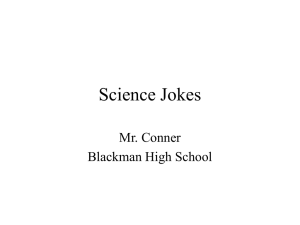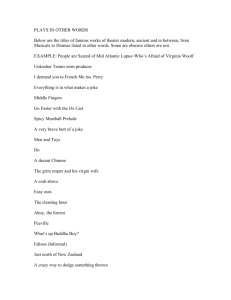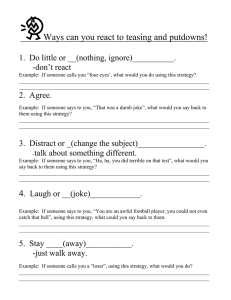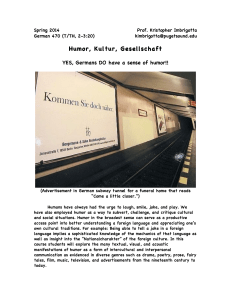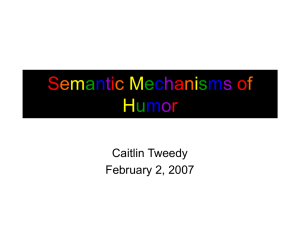Do Jokes Have to Be Funny: Analysis of 50 “Theoretically... Julia M Taylor
advertisement
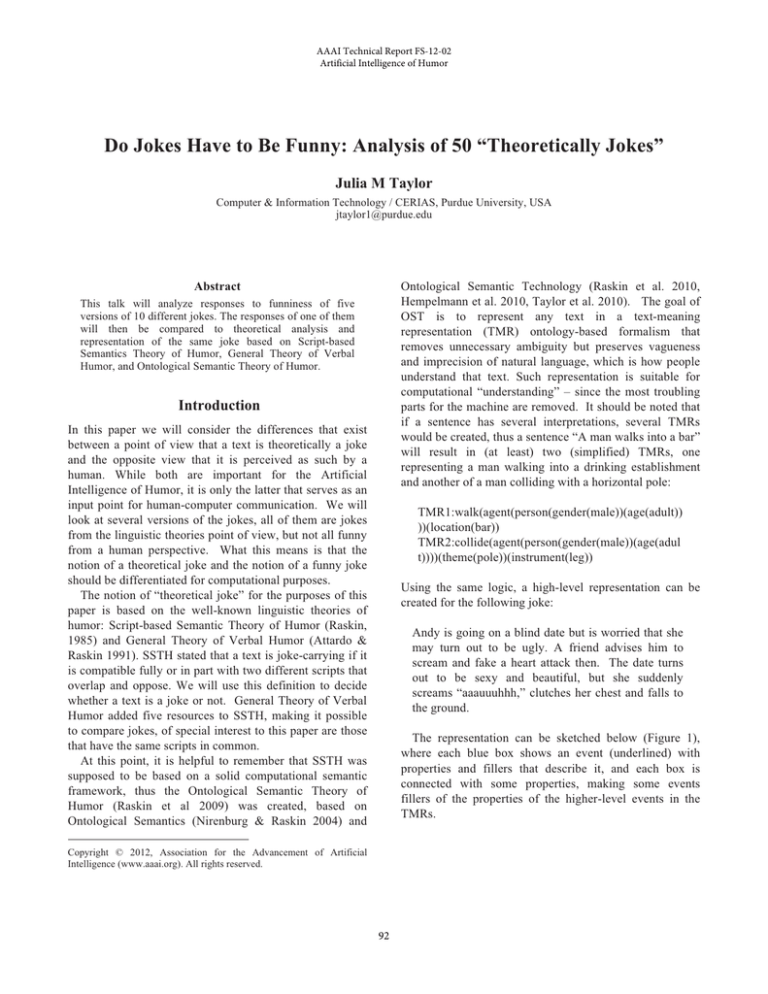
AAAI Technical Report FS-12-02 Artificial Intelligence of Humor Do Jokes Have to Be Funny: Analysis of 50 “Theoretically Jokes” Julia M Taylor Computer & Information Technology / CERIAS, Purdue University, USA jtaylor1@purdue.edu Ontological Semantic Technology (Raskin et al. 2010, Hempelmann et al. 2010, Taylor et al. 2010). The goal of OST is to represent any text in a text-meaning representation (TMR) ontology-based formalism that removes unnecessary ambiguity but preserves vagueness and imprecision of natural language, which is how people understand that text. Such representation is suitable for computational “understanding” – since the most troubling parts for the machine are removed. It should be noted that if a sentence has several interpretations, several TMRs would be created, thus a sentence “A man walks into a bar” will result in (at least) two (simplified) TMRs, one representing a man walking into a drinking establishment and another of a man colliding with a horizontal pole: Abstract This talk will analyze responses to funniness of five versions of 10 different jokes. The responses of one of them will then be compared to theoretical analysis and representation of the same joke based on Script-based Semantics Theory of Humor, General Theory of Verbal Humor, and Ontological Semantic Theory of Humor. Introduction In this paper we will consider the differences that exist between a point of view that a text is theoretically a joke and the opposite view that it is perceived as such by a human. While both are important for the Artificial Intelligence of Humor, it is only the latter that serves as an input point for human-computer communication. We will look at several versions of the jokes, all of them are jokes from the linguistic theories point of view, but not all funny from a human perspective. What this means is that the notion of a theoretical joke and the notion of a funny joke should be differentiated for computational purposes. The notion of “theoretical joke” for the purposes of this paper is based on the well-known linguistic theories of humor: Script-based Semantic Theory of Humor (Raskin, 1985) and General Theory of Verbal Humor (Attardo & Raskin 1991). SSTH stated that a text is joke-carrying if it is compatible fully or in part with two different scripts that overlap and oppose. We will use this definition to decide whether a text is a joke or not. General Theory of Verbal Humor added five resources to SSTH, making it possible to compare jokes, of special interest to this paper are those that have the same scripts in common. At this point, it is helpful to remember that SSTH was supposed to be based on a solid computational semantic framework, thus the Ontological Semantic Theory of Humor (Raskin et al 2009) was created, based on Ontological Semantics (Nirenburg & Raskin 2004) and TMR1:walk(agent(person(gender(male))(age(adult)) ))(location(bar)) TMR2:collide(agent(person(gender(male))(age(adul t))))(theme(pole))(instrument(leg)) Using the same logic, a high-level representation can be created for the following joke: Andy is going on a blind date but is worried that she may turn out to be ugly. A friend advises him to scream and fake a heart attack then. The date turns out to be sexy and beautiful, but she suddenly screams “aaauuuhhh,” clutches her chest and falls to the ground. The representation can be sketched below (Figure 1), where each blue box shows an event (underlined) with properties and fillers that describe it, and each box is connected with some properties, making some events fillers of the properties of the higher-level events in the TMRs. Copyright © 2012, Association for the Advancement of Artificial Intelligence (www.aaai.org). All rights reserved. 92 4. Andy is going on a blind date. He asks a friend, “What do I do if she’s ugly?” The friend advises him, “If you don’t like what you see, just clutch your chest and fake a heart attack.” The date turns out to be beautiful and sexy, but she suddenly clutches her chest and falls to the ground. (59 words) 5. Andy is going on a blind date but is worried that she may turn out to be ugly. A friend of both advises him to scream and fake a heart attack if he doesn’t want to stay for a long time. When Andy comes to the provided address, the date turns out to be beautiful and sexy, but she suddenly screams “aaauuuhhh,” clutches her chest and falls to the ground. (71 words) These jokes can be compared with GTVH, as shown in Table 1: V1 V2 V3 V4 V5 SO real/non-real LM reversal SI blind date TA n/a NS dialog dialog no dialog no dialog dialog LA Figure 1: Scripts of the joke Jokes and Their Variations, In Theory An interesting question is, then, whether we can compare texts that are similar to this sketch (relative to events, properties, fillers) and conclude that they are jokes, based on the GTHV parameters. Ideally, texts that we conclude to be jokes are funny to people. Let us consider 5 versions of the same joke: 1. Danny sets up Andy to go on a blind date with Shirley, a friend of a friend of his. But Andy is a little worried about going out with someone he has never seen before. "What do I do if she's ugly?" says Andy, "I'll be stuck with her all night." "Don't worry." Danny says. "Just go up to her door and meet her first. If you like what you see, then everything goes as planned. If you don't, just shout Aaauuuggghhh! clutch your chest and fake a heart attack." So that night, Andy knocks on Shirleys door, and when she comes out he is awe-struck with how beautiful and sexy she is. Andy's about to speak when the girl suddenly shouts, "Aaauuuggghhh!", clutches her chest and falls to the ground. (132 words) 2. Sam didn't want to go on the blind date that Tom had arranged for him. "What if she's really ugly and I hate her?" he complained. "Then just clutch your chest and fake a heart attack," Tom replied. Sam thought this was a good idea, so he agreed to go through with it. He went to the address Tom had given him, and a beautiful woman answered the door. "Hi, I'm your blind date!" Sam said. The woman clutched her chest and fell to the ground. (87 words) 3. Andy is going on a blind date but is worried that she may turn out to be ugly. A friend advises him to fake a heart attack then. The date turns out to be beautiful and sexy, but she suddenly clutches her chest and falls to the ground. (49 words) Table 1: GTVH Analysis of 5 variants of the same joke What is interesting in this comparison is that the jokes differ essentially in the narrative strategy. At a finer grain size (as pointed out by Hempelmann, personnal communication), some of the jokes have a slightly different logical mechanism: some of them explain that a friend that advices the male actor of the blind date is actually a friend of both parties, thus providing a potential explanation why the girl used the same trick. In other words, using Incongruity-Resolution terminology, resolution is more complete. Yet, what is not clear, even with such granular view of logical mechanism, is how to represent these differences in GTVH-related terms (see Hempelmann & Attardo 2011 for further discussion). What is possible is to represent events that are happening in the jokes using the apparatus of the Ontological Semantic Technology and compare them that way. It is also possible to use OST representation to mark variations in all of the knowledge resources of GTVH. Figure 2 demonstrates the exercise outlined above. Each of the blocks in the figure represents an event in a joke. The colored rectangles above each block indicate whether or not a version of the joke contained the event in question. For example, orange indicates those events that were described in the first version of the joke. Thus, in anticipating the date script the following event-like structures were activated: WORRY, BLIND-DATE, SETUP, ADVICE, SCREAM, CLUTCH, APPEARANCE, MEET, MOTIONEVENT AND HEART-ATTACK. 93 % $ % % ! % % ! ! $ $ $ " % $# % $ $ $ ! % ! % % $ $ $ $ $ $ % ! % ! $ $ Figure 2: Comparison of five variants of the same joke • • • • • long non-manipulated version shorter manipulated version non-dialogue manipulated minimalist version dialogue manipulated minimalist version longer manipulated minimalist version with paraphrasing If we are to explain it in terms of the GTVH parameters, each joke could be characterized by Table 2, where SO, LM, and SI were different for each joke i, but the same for all variations within the joke i. What do people find funny? The next question to be answered is: what do people find funny, or rather, are all those theoretical jokes funny? To answer this question we conducted a small pilot study, where subjects were asked to rate the funniness of each joke described above and 5 variants of 9 more jokes (see Hempelmann et al 2012). We thus ended up with 50 texts, consisting of 10 jokes found online in at least two variants differing in length, complemented by another three synthesized variants for each joke: one is the minimalist version, condensing the joke to a summary only mentioning the necessary and, presumably sufficient information for the joke to be operational; another is this minimalist version together with a dialogue element in the Narrative Structure of the joke, since we realized in creating the non-dialogue minimalist version that the joke seemed to us radically decreased in funniness; the third artificial variant was added to be just that, a control version based on the longer real variant of the joke, to see if artificial manipulation in itself affected perceived funniness. The rationale for the final version is based on the fact that jokes are folkloristic creations optimized by iterations of retelling and not owned by individual authors, a characteristic that does not hold for cut-and-paste online joke collections created to generate traffic. In sum, the five variants for each of the ten jokes are: SO LM SI TA NS V1 V2 dialog dialog V3 SOi LMi SIi n/a no dialog V4 V5 dialog no dialog LA Table 2: Knowledge Resources of 10 jokes As explained in Hempelmann et al (2012), we recruited raters for the funniness of these variants using Amazon’s Mechanical Turk, a method generally deemed valid (Buhrmester et al. 2011) and now proclaimed to be a form of ‘human computation (Law and von Ann 2011), with an incentive of $0.10 for participation. The following distribution of funniness was found for the variants of Joke 1 (see Figure 2 for comparison) 94 HUMOR – International Journal of Humor Research. 24-2: 125149. Hempelmann, C. F., Taylor, J. M., & Raskin, V. (2010). Application-guided Ontological Engineering. Proceedings of the International Conference on Artificial Intelligence, Las Vegas, NE. Hempelmann, C. F., Taylor, J. M., & Raskin, V. (2012). Tightening up joke structure: Not by length alone. CogSci ’12: Annual Meeting, Cognitive Science Society, Sapporo, Japan. Law, E., and von Ann, L. (2011). Human Computation. No place: Morgan & Claypool. Nirenburg, S., & Raskin, V. (2004). Ontological Semantics. Cambridge, MA: MIT Press. Raskin, V. (1985). Semantic Mechanisms of Humor. Dordrecht: Reidel. Raskin, V., Hempelman, C. F., & Taylor, J. M. (2009). How to understand and assess a theory: The evolution of the SSTH into the GTVH and now into the OSTH, Journal of Literary Theory 3(2), 285-312. Raskin, V., Hempelmann, C. F., & Taylor , J. M. (2010). Guessing vs. knowing: The two approaches to semantics in natural language processing, Annual International Conference Dialogue 2010, 642-650, Bekasovo (Moscow), Russia. Taylor, J. M. (2012) OSTH at work—Lessons learned; Hopes Intact, Computational Humor Workshop, Amsterdam, Netherlands, June 2012 Taylor, J. M., Hempelmann, C. F., & Raskin, V. (2010a). On an automatic acquisition toolbox for ontologies and lexicons in Ontological Semantics, International Conference on Artificial Intelligence, Las Vegas, NE. V1 V2 V3 V4 V5 mean 3.7 4.1 3.2 3.4 3.2 st dev 1.17 0.9 1.1 1.1 1.1 n 42 29 40 40 37 Table 3: Funniness rating of variants of Joke 1 While at first it may look like the distinction between dialog and no-dialog looks promising, analysis of other jokes show that it is not always the case (see Figure 3): Figure 3: Funniness rating of variants of all 10 jokes Figure 3 indicates that very few variations of jokes raised above 4 (funny), at the same time only few fell below 3 (neutral). Most of the ratings are between these two categories. What is not clear yet is whether there is some correlation between funniness rating of humans with events that can be used for the representation of these jokes and their varients. What is clear, although not necessarily new, is that niether SSTH nor GTVH at its coarse form can predict or explain why some varients of the same jokes have higher ratings. Acknowledgements This work is the result of experiment developed and implemented in collaboration with Christian Hempelmann and Victor Raskin, and benefited from discussions at the ISHS’11 and ISHS’12. References Attardo, S., & Raskin, V. (1991). Script theory revis(it)ed: joke similarity and joke representation model. Humor: International Journal of Humor Research 4(3-4): 293-347. Buhrmester, M., Kwang, T., & Gosling, S.D. (2011). Amazon’s Mechanical Turk: A New Source of Inexpensive, Yet HighQuality, Data? Perspectives on Psychological Science , 6(1), 3-5. Hempelmann, C. F. & Attardo, S. (2011) Resolutions and Their Incongruities: Further Thoughts on Logical Mechanisms. 95
